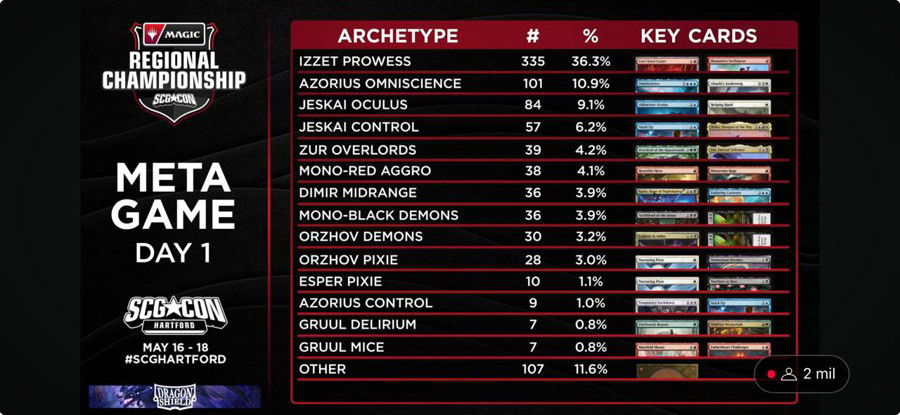There was a time when reprinting Dark Confidant was unthinkable. Since its release in Ravnica: City of Guilds, it quickly became one of, if not the best creature of all time in Magic — technically, it was the one that started the “cycle” of powerful two-drops that, in the following years, would permeate the main competitive formats.
The cycle was updated two years later, with Tarmogoyf being the best green creature in the game. In 2011, the cycle gained its third tool with Stoneforge Mystic, which in addition to starring in one of the most broken decks in the history of Standard, gave rise to Stoneblade, which manifested itself in the most varied color combinations in Legacy and led to a preemptive ban in Modern. Finally, Innistrad brought Snapcaster Mage, another multi-format staple for many years.
Time passed, and before red could gain its representative in the cycle (some argued it was Eidolon of the Great Revel while others named Young Pyromancer), Modern Horizons arrived in 2019 and changed the way we looked at power level in Magic. Its successor, Modern Horizons II, sent power creep sky-high: who was Dark Confidant next to Ragavan, Nimble Pilferer? What good was a Snapcaster Mage when Grief offered an Unmask with a 3/2 body with Menace and Murktide Regent was an improved Gurmag Angler in blue?
Power creep wasn't limited to Modern Horizons and also permeated Standard with the F.I.R.E. philosophy adopted by the design team starting with War of the Spark. The idea was that every card needed to be Fun, Inviting, Replayable & Exciting. The result was a dozen bans during two or more turbulent Standard seasons and admitted design mistakes like Oko, Thief of Crowns, Uro, Titan of Nature's Wrath, Companions like Lurrus of the Dream-Den, among a dozen other cards that didn't necessarily break many formats (Omnath, Locus of Creation), but set the playability bar too high.It's 2025, and we're in the middle of previews for Final Fantasy, which will be the first Standard-legal set in the Universes Beyond series. So far, despite the dozen or so overcosted mana-value cards that should only be relevant in casual or Commander play, there are at least three cards that should be blowing players' minds right now: A near-Stoneforge Mystic, a near-Sword of Fire and Ice, and, quite literally, Dark Confidant.

But we're not. While there's some discussion around the potential of these cards, there's no sign that they'll be the staples in Standard that they used to be in Modern and Legacy. For years, it would have seemed crazy to reprint Dark Confidant or even dream of half a Stoneforge Mystic for two mana in Standard. Until 2023, the idea of a card with the design of Mirrodin's swords coming to Standard seemed insane, and that the sure way to end their cycle would be in the Modern Horizons products, and if not even the Swords we have today had competitive relevance, why would one that offers no protection?
We have all these tools coming to Standard, and we're not excited. On the contrary, we have doubts whether these cards will even be playable within the format's competitive Metagame.
Ad
The lack of excitement about these cards has two clear reasons:
The state of Standard prevents many cards from having a chance to shine
If we look at the Tarkir: Dragonstorm metagame, we see an environment that is too fast and efficient for “fairer cards” like Buster Sword or even Dark Confidant because they require an extra turn or too much mana to work.
While you are casting Buster Sword and paying 
In this same scenario, Buster Sword also doesn't compare to casting Abuelo's Awakening for Omniscience, or untapping with Abhorrent Oculus, nor triggering an Up the Beanstalk by playing Overlord of the Hauntwoods that, on the next turn, will attack as a 5/5 with Lifelink and Hexproof when we activate Zur, Eternal Schemer — all of the above scenarios represent some of the most played decks in the Regonal Championship in Hartford, which took place between May 16 and 18.

Ad
Dark Confidant has the same problem, and then some: it's absurd next to cards with low mana value, but not even in the fairest Midranges, can it find space next to Kaito, Bane of Nightmares with Floodpits Drowner and Enduring Curiosity or is nowhere as good as Unholy Annex with Archfiend of the Dross? Unfortunately, it doesn't play alongside these cards because revealing something costing four or more in such an aggressive environment means a quick defeat, and most of these lists run too many cards with that mana value.
Furthermore, Standard today is too fast and synergistic for cards with slow individual power levels. Even if Cloud, Midgar Mercenary were, line for line, a Stoneforge Mystic, we don't have Batterskull, Sword of Feast and Famine or Kaldra Compleat to justify using it over faster cards, and even if we're casting it to fetch Cori-Steel Cutter, we're still doing worse than other decks in the current Metagame.

Unless you're in a deck that's trying to get the most out of Cloud, you'd probably want to go with Cori-Steel Cutter before Buster Sword or Sword of Forge and Frontier in the list, simply because Cutter provides value even when unequipped and doesn't require extra mana investment to become a threat on the board and dictate the game, unlike most equipment.
It could be that Cori-Steel Cutter is a bit too good for Standard — the Izzet Prowess' numbers past weekend point to that — and it could be that Monstrous Rage, which is notoriously more mana-efficient than trying to cast and equip any artifact, is also a bit too good.
But in addition to these, we have the interaction of Abhorrent Oculus with Helping Hand, or Zur, Eternal Schemer with the Overlords, Sunpearl Kirin and Nurturing Pixie with efficient ETBs and power plays like Kaito, Bane of Nightmares, or just the mice package with Manifold Mouse and cheap pumps. All of them show that cards that were once absurdly strong risk being irrelevant today, as happened with Liliana of the Veil.

Liliana was once the second best Planeswalker of all time and for many years was a centerpiece of Modern's Midrange, sometimes even creating archetypes around her with The Rack. When she was reprinted in Dominaria United, her impact on competitive play was relatively small. Yes, she did show up in a few maindeck lists, then moved to the Sideboard and is now a maybe for these black Midranges where, before, she was a defining pillar.
Ad
Dark Confidant could follow suit. Yes, it is also possible to reduce the mana values to accommodate it instead of Unholy Annex or Kaito, Bane of Nightmares and Enduring Curiosity, but wouldn't it still be doing something worse by losing life in a notoriously Aggro Metagame? Are there circumstances and basis in Standard and Pioneer for it to be a maindeck card?
At this point, it is likely not. And Bob, as he was called, has become obsolete by what Magic is in 2025
Power Creep is a natural force
Despite criticism of how power creep makes some effects and cards that made history seem weak even for Standard, this event is a natural force in card games and has occurred in many circumstances.

Before Dark Confidant, there was Phyrexian Arena. Before Tarmogoyf, the win condition was Spiritmonger for Midrange and Quirion Dryad for Tempo decks, and before Thoughtseize, Duress was the best discard spell in the game.
Where Psychatog was once one of the best creatures in the format, Tarmogoyf and other cards have taken its place. If Loxodon Hierarch once had a place in competitive play, it lost it the moment Kitchen Finks — currently irrelevant — was released in Shadowmoor, and the same can be said of many other cards. It is a natural part of any ongoing game that stronger pieces come out over the years and make the old pieces obsolete.
Bob might have stopped being a power play that demands immediate response when everything else the other players are also doing qualifies as a “power play” — will he win the game if he is not answered? Probably because an extra draw per turn stacks easily, but everything the opponent does also wins the game under the same conditions. Standard is, today and has been for a long time, based on sequencing cards that say “deal with it now”.
Ad

It's not that there's no synergy or interaction, but that there's so much individual value in each card that it's challenging to get answers to them, while leaving most of them on the board undoes any progress a player has made in the game. Dark Confidant does the same, but it matters when everything has the same impact on the game that untapping with it used to.
Will Universes Beyond make a difference in this equation?
When they announced that three Universes Beyond sets would be coming to Standard, there were a few possibilities for how they could impact the format and what changes they would bring.
Initially, I imagined that, since it has a premium product price and the idea of making Standard more inviting for fans of these brands who know Magic through them, sets like Final Fantasy or Spider-Man would push the power level — which is already naturally high — a little higher. Something similar to Lord of the Rings, but without the obvious powerhouses like Orcish Bowmasters and The One Ring, but with enough Flame of Anor and Delighted Halflings.
We are in the middle of Final Fantasy preview season as I write this article, and the feeling of the set so far is that it is “on par” with what we saw with Aetherdrift and Tarkir: Dragonstorm. Yes, there are some potential staples like the aforementioned cards, plus Vivi Ornitier as a build-your-own Storm and Sephiroth, Fabled SOLDIER as the first creature to create an Emblem, but overall, FF is very well-balanced compared to what we've seen with this year's releases.
This is a great sign for Standard, but it does come with a problem: will the person who comes to FNM at their local store to play Standard after learning about Magic through these brands have a place? One of the biggest problems with Lord of the Rings was that it was directly inserted into Modern for the same reason: what's the point of Aragorn, the Uniter having four colors and a powerful ability when it doesn't even compare to Ragavan, Nimble Pilferer in a higher power level environment?
Yes, the set had a dozen cards that saw and still see play in the format: The One Ring was banned, Flame of Anor is still present, Delighted Halfling and Orcish Bowmasters are staples, and Stern Scolding is an important sideboard piece, but the rest of Lord of the Rings doesn't even have a chance to blend in with the rest of Modern. If most of them had come out for Standard, it's likely that we would have had pieces like Flowering of the White Tree and Samwise the Stouthearted playing alongside Thalia, Guardian of Thraben last season and in Pioneer.
Ad
The first half of Final Fantasy shows signs that it and future Universes Beyond sets will face the same problem, despite the legality change. It's natural that only a dozen cards from each expansion have competitive viability; it's always been and will be that way in any game.
The problem is that the most powerful cards revealed so far don't seem to come close to what we're doing in Standard today, and not even having the chance to play these fan-favorite cards in an FNM tournament will certainly drive that audience away from competitive play and straight to Commander, resulting in yet another blow to Wizards' attempts to revitalize Standard.
Maybe it doesn't have to be like this forever: one of the advantages of the three-year rotation is that Sephiroth, Miles Morales or Aang will have that entire period to make a difference and gain synergies and interactions with each new set that comes out. But that same three-year rotation is the cause of part of the symptoms that drive these cards away from competitive play — without direct intervention, cards like Cori-Steel Cutter or Up the Beanstalk will continue to permeate competitive play and build decks around them, while invalidating a dozen other options. The three years of Final Fantasy are also the three years of Tarkir: Dragonstorm.
I'm not advocating that we should ban cards for FF or any Universes Beyond expansion to be more relevant. On the contrary: the existence of this audience should not interfere with the way Magic is played at competitive tables, but as long as there is a pool of cards that invalidate the possibility of playing them for pure speed — Izzet Prowess, Red Mice — or for anti-play patterns — Azorius Omniscience, Domain Overlords —, Standard will not be inviting to this audience, and the format needs to serve as the main gateway to Magic tournaments, the main means of renewing the audience for the competitive scene.
How to fix the power level discrepancy?
The best option may be not to fix it.
Power creep is a natural part of Magic, and it is not good for the game's integrity for more rules to be subverted to make Standard more inviting to build decks around Cloud or Peter Parker — there's no direct intervention that would keep these changes viable in the long run, and it would only take two or three more sets for these cards to potentially be invalidated again. So it's best to let Standard resolve itself naturally.That doesn't mean we don't need bans or interventions from Wizards to manage the format. The numbers from Izzet Prowess today speak volumes about the format's speed and its trial period. If Final Fantasy doesn't change the current best deck, it's likely that the next Banned and Restricted announcement will remove the equipment from the format, and perhaps a dozen other cards discussed in the past like Heartfire Hero / Monstrous Rage and Up the Beanstalk to create a fresh environment as we approach the rotation that will also remove Zur, Eternal Schemer, Pain Lands, and a dozen other key cards from the Metagame.
Ad
Keeping bans to a minimum is good for the integrity of Standard's investment, but it hurts the format's overall performance. Due to the number of matches that occur daily in Magic Arena, the format has become much easier to solve, and if a deck is the best, it will remain the best for a long time.
Yearly bans like maintenance do help to make the rotation period more interesting and inviting, but they may not be enough for the rest of the year. Would a ban on Monstrous Rage five months ago have solved any of the problems we face today? Probably not because Izzet Prowess doesn't rely on the card as much to operate, in the same way that the main Up the Beanstalk strategy isn't as popular in the Metagame today.
On the other hand, seeing cards like Dark Confidant revealed and met with skepticism is both a sign of the times and a clear consequence of the kind of Standard we're living in — where one of the most powerful creatures in Magic history wasn't even given much room to debate how to get the most out of it after Final Fantasy's release.
While this is a natural power creep move, it may also be a sign that something needs to change in the way Wizards of the Coast is managing Standard and Pioneer.
Maybe I'm wrong and the first few weeks after release will put Bob back in the competitive spotlight as a mainstay of Standard alongside a cheap and efficient Midrange shell hat offers some advantages over current versions, or possibly, he'll be an important piece for Aggro decks — or perhaps his golden days are truly over, and he'll see as much play as Caustic Bronco or the other variants that existed for years in the format because “Dark Confidant was too strong for Standard”.
Thanks for reading.








— Commenti
0Diventa il primo a commentare